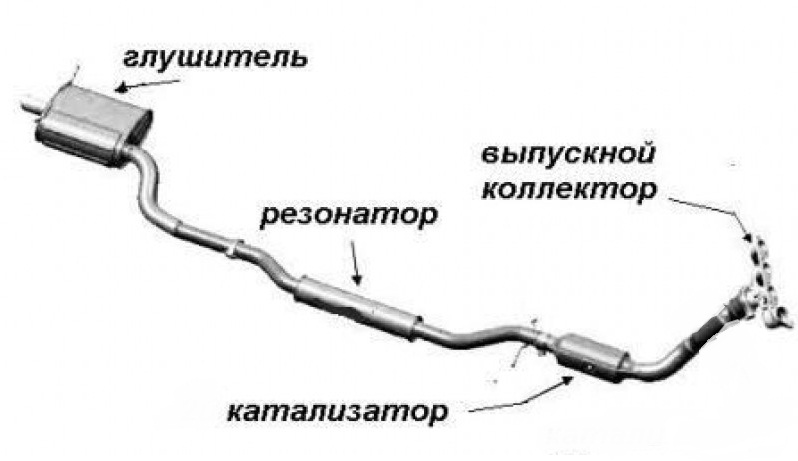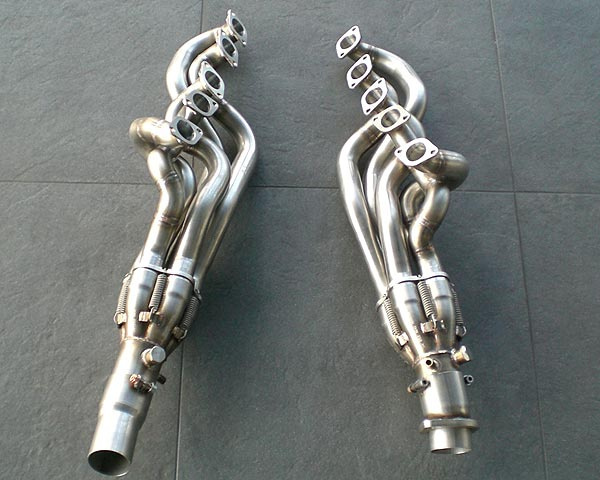
Exhaust system - device
A car equipped with an internal combustion engine needs a system through which exhaust gases are emitted. Such a system, called the exhaust, appeared simultaneously with the invention of the engine and, along with it, has been improved and modernized over the years. What the exhaust system of a car consists of and how each of its components works, we will tell you in this material.
Three pillars of the exhaust system
When the air-fuel mixture is burned in the engine cylinder, exhaust gases are formed, which must be removed so that the cylinder is refilled with the required amount of the mixture. For these purposes, automotive engineers invented the exhaust system. It consists of three main components: exhaust manifold, catalytic converter (converter), muffler. Let's consider each of the components of this system separately.

Exhaust system diagram. In this case, the resonator is an additional muffler.
The exhaust manifold appeared almost simultaneously with the internal combustion engine. It is an engine accessory consisting of several tubes that connect the combustion chamber of each engine cylinder to the catalytic converter. The exhaust manifold is made of metal (cast iron, stainless steel) or ceramic.

Manifold
Since the collector is constantly under the influence of high exhaust gas temperatures, collectors made of cast iron and stainless steel are more “workable”. A stainless steel collector is also preferable, since condensate accumulates in the unit during the cooling process after the vehicle has stopped. Condensation can corrode a cast iron manifold, but corrosion does not occur on a stainless steel manifold. The advantage of a ceramic manifold is its low weight, but it cannot withstand high exhaust gas temperatures for a long time and cracks.

Hamann exhaust manifold
The principle of operation of the exhaust manifold is simple. Exhaust gases pass through the exhaust valve to the exhaust manifold and from there to the catalytic converter. In addition to the main function of removing exhaust gases, the manifold helps to purge the combustion chambers of the engine and “collect” a new portion of exhaust gases. This happens due to the difference in gas pressures in the combustion chamber and manifold. The pressure in the manifold is lower than in the combustion chamber, so a wave is formed in the manifold pipes, which, reflected from the flame arrester (resonator) or catalytic converter, returns to the combustion chamber, and at this moment in the next exhaust stroke it helps to eliminate the next portion of gases. Speed the creation of these waves depends on the speed of the engine: the higher the speed, the faster the wave will "walk" along the collector.
From the exhaust manifold, the exhaust gases enter the converter or catalytic converter. It consists of ceramic honeycombs, on the surface of which there is a layer of platinum-iridium alloy.

Schematic of the catalytic converter
Upon contact with this layer, nitrogen and oxygen oxides are formed from the exhaust gases as a result of a chemical reduction reaction, which is used to more efficiently burn fuel residues in the exhaust. As a result of the action of the catalyst reagents, a mixture of nitrogen and carbon dioxide enters the exhaust pipe.
Finally, the third main element of the car's exhaust system is the muffler, which is a device designed to reduce the noise level when exhaust gases are emitted. It, in turn, consists of four components: a tube connecting the resonator or catalyst to the silencer, the silencer itself, the exhaust pipe and the exhaust pipe tip.

Muffler
Exhaust gases purified from harmful impurities come from the catalyst through the pipe to the muffler. The muffler body is made of various grades of steel: ordinary (service life - up to 2 years), aluminized (service life - 3-6 years) or stainless steel (service life - 10-15 years). It has a multi-chamber design, with each chamber provided with an opening through which exhaust gases enter the next chamber in turn. Thanks to this multiple filtering, the exhaust gases are damped, the sound waves of the exhaust gases are damped. The gases then enter the exhaust pipe. Depending on the power of the engine installed in the car, the number of exhaust pipes can vary from one to four. The last element is the exhaust pipe tip.
Turbocharged vehicles have smaller mufflers than naturally aspirated vehicles. The fact is that the turbine uses exhaust gases to work, so only some of them get into the exhaust system; so these models have small mufflers.
